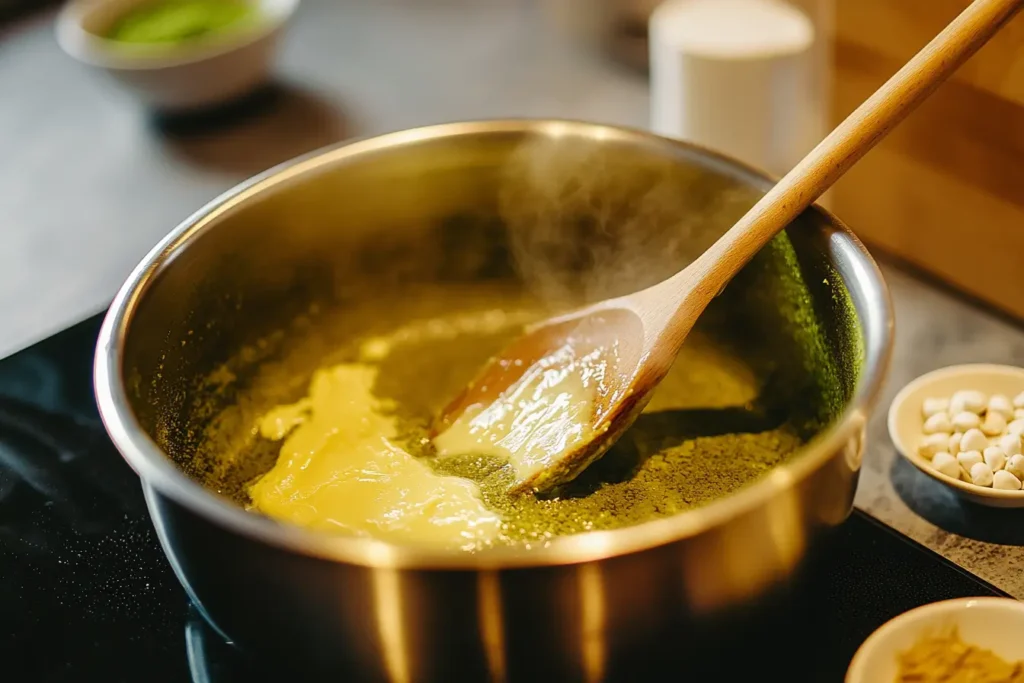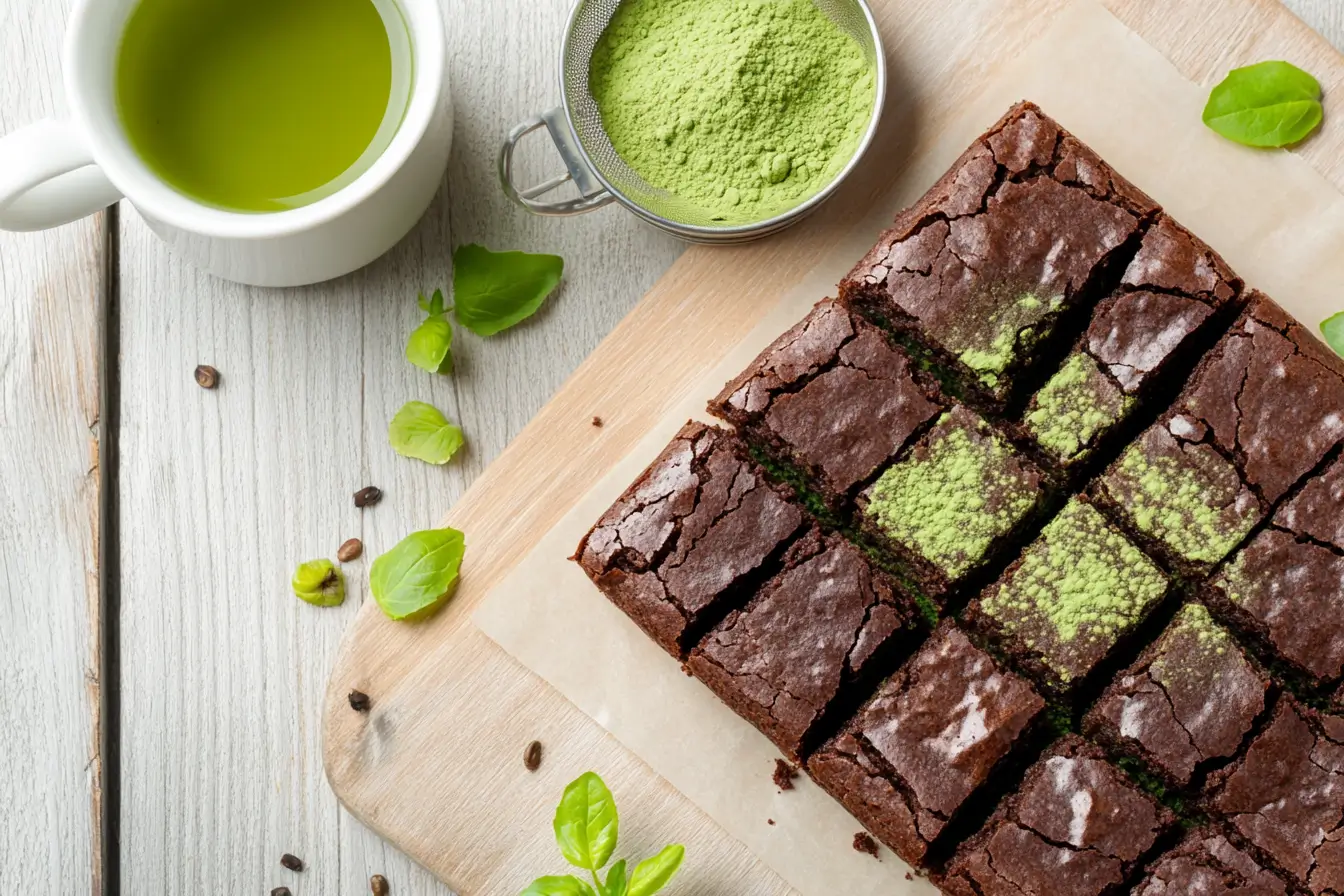Introduction
If you love the rich, fudgy goodness of brownies and the earthy, slightly sweet flavor of matcha, then matcha brownies should be your next bake! These vibrant green desserts are not only visually stunning but also pack a unique flavor that’s perfect for adventurous bakers. However, many home bakers face a common problem: Why are my matcha brownies brown? Instead of the vibrant green hue that makes matcha desserts stand out, some batches come out looking dull or even unappetizingly brown.
This frustrating issue usually stems from a combination of factors, such as the quality of matcha powder, baking techniques, or ingredient choices. Understanding how matcha behaves in baking is key to creating brownies that taste amazing and maintain their signature green color. In this detailed guide, we’ll explore everything you need to know, from the science behind matcha discoloration to practical tips for baking the perfect brownies. Let’s dive in!
What is Matcha and Why Does It Impact Matcha Brownies’ Color?
Matcha powder, made from finely ground green tea leaves, is the key to the vibrant green color of matcha brownies. Choosing the right matcha directly impacts not only the taste but also the color of your dessert.
Ceremonial vs. Culinary Matcha
There are two main types of matcha:
- Ceremonial Grade: The highest quality, used in traditional Japanese tea ceremonies. It’s bright green, smooth, and slightly sweet, making it ideal for drinking but often too delicate and expensive for baking.
- Culinary Grade: Designed for cooking and baking, this type of matcha has a more robust flavor and vibrant color. It’s less sweet than ceremonial matcha but works perfectly in desserts where other ingredients balance its bitterness.
When baking matcha brownies, using culinary-grade matcha ensures you get the best color and flavor. Keep in mind that matcha oxidizes when exposed to air, light, or heat, so it’s essential to store it in a cool, dark place and use it within a few months for the best results.
Check out this guide on matcha as an underrated baking ingredient for more insights.
Why Are My Matcha Brownies Brown Instead of Green?
Understanding why matcha brownies turn brown is essential for perfecting your recipe. This could be due to low-quality matcha, oxidation, or baking techniques.
1. Is Low-Quality Matcha Making Your Brownies Less Green?
Not all matcha powders are equal. Using poor-quality matcha can result in dull, brownish brownies.
The quality of matcha powder has a direct impact on the final color of your brownies. Low-quality or expired matcha often lacks the bright green chlorophyll pigments that give matcha desserts their iconic look.
Solution: Invest in high-quality culinary-grade matcha with a rich green color. Avoid powders that appear yellowish or brown, as they are unlikely to produce the desired results.
2. Over-Baking
Excessive baking time or high oven temperatures can oxidize matcha, causing it to lose its color and turn brown.
Solution: Bake matcha brownies at 350°F (175°C) and check for doneness after 20–25 minutes. A toothpick inserted in the center should come out with a few moist crumbs, not dry.
2. Are Over-Baking and Oxidation Turning Your Matcha Brownies Brown?
Over-baking and exposing matcha to heat and air are common reasons for matcha desserts losing their color.
Solution: Minimize the time the batter sits before baking, and preheat your oven so the brownies go in immediately after mixing.
4. Baking Powder vs. Baking Soda
The leavening agent you use can impact matcha’s color. Baking soda is more alkaline and may cause discoloration, while baking powder is milder and better suited for preserving color.
Solution: Use baking powder for matcha desserts to maintain their bright green appearance.
5. Improper Mixing or Ingredient Ratios
Uneven mixing or incorrect ingredient proportions can affect the final color. For example, too much butter or chocolate can overshadow matcha’s green pigments.
Solution: Follow a reliable recipe with precise measurements and gently fold in dry ingredients to avoid deflating the batter.
Learn more about matcha’s role in desserts by exploring the matcha brownies recipe.
Ingredients for Perfect Matcha Brownies with Vibrant Color
Using the right ingredients, such as high-quality culinary-grade matcha powder, ensures your matcha brownies retain their green hue.
Key Ingredients
- Matcha Powder (2 tbsp): Opt for high-quality culinary-grade matcha to ensure a vibrant green color and balanced flavor.
- Unsalted Butter (1/2 cup): Browning the butter enhances its nutty, caramel-like flavor, adding depth to the brownies.
- White Chocolate (4 oz): Adds sweetness and complements the earthy flavor of matcha.
- Granulated Sugar (1 cup): Provides sweetness and structure to the brownies.
- All-Purpose Flour (3/4 cup): The foundation for the brownie’s structure and texture.
- Eggs (2 large): Adds moisture and binds the ingredients together.
- Baking Powder (1/2 tsp): Helps the brownies rise gently while preserving their color.
Optional Toppings
- Flaky Sea Salt: A savory touch that balances the sweetness.
- Powdered Sugar or White Chocolate Drizzle: For added visual appeal and flavor.
Ingredient Tips
- Sift the Dry Ingredients: Sifting ensures even color distribution and prevents clumps.
- Use Light-Colored Pans: Dark pans absorb more heat, which can lead to browning.
Step-by-Step Recipe to Avoid Matcha Brownies Turning Brown

Follow these instructions to bake fudgy, perfectly green matcha brownies. From browning butter to proper sifting, every step matters.
1. Prepare Your Pan and Oven
- Preheat your oven to 350°F (175°C).
- Grease and line an 8×8-inch baking pan with parchment paper, leaving an overhang for easy removal.
2. Brown the Butter
- Melt the butter in a light-colored saucepan over medium heat. Swirl the pan occasionally until the butter turns golden brown and emits a nutty aroma.
- Remove from heat and allow it to cool slightly to avoid cooking the eggs in the batter.
3. Melt the White Chocolate
- Combine the browned butter and white chocolate in a heatproof bowl. Stir until smooth and fully melted.
4. Mix the Wet Ingredients
- In a large mixing bowl, whisk the eggs and granulated sugar until pale and frothy. This step incorporates air for a lighter texture.
- Gradually add the butter-chocolate mixture while whisking continuously to avoid curdling.
5. Add the Dry Ingredients
- Sift the matcha powder, flour, and baking powder into the wet mixture. Gently fold using a spatula until just combined. Over-mixing can deflate the batter and affect texture.
6. Bake
- Pour the batter into the prepared pan, spreading it evenly with a spatula. Smack the pan gently on the counter to release air bubbles.
- Bake for 20–25 minutes. Check for doneness by inserting a toothpick into the center; it should come out with a few moist crumbs.
7. Cool Completely
- Allow the brownies to cool completely in the pan before slicing. This helps maintain their structure and ensures clean edges.
Tips for Perfect Matcha Brownies
- Sift Matcha Powder: Prevents clumps and ensures an even green color throughout the batter.
- Avoid Over-Baking: Check the brownies early to prevent oxidation and browning.
- Use Fresh Matcha: Expired or improperly stored matcha can result in dull-colored desserts.
Refer to this guide to chocolate and matcha pairing desserts for baking tips.
The Role of Matcha Quality in Baking
One of the most critical factors in baking matcha brownies is the quality of matcha powder. Poor-quality matcha not only dulls the color of your brownies but also compromises their flavor. Here’s how to ensure your matcha enhances your bake:
1. Ceremonial vs. Culinary Matcha
- Ceremonial Grade Matcha: This premium matcha is vibrant green, smooth, and slightly sweet. It’s ideal for drinking but not necessarily for baking, as its delicate flavor can be overshadowed by other ingredients.
- Culinary Grade Matcha: This type of matcha is specifically crafted for cooking and baking. It’s less sweet but more robust, ensuring the flavor holds up during baking.
2. Why Quality Matters
High-quality matcha is rich in chlorophyll and antioxidants, which give it its signature bright green color. Low-quality or old matcha, on the other hand, may appear yellowish or brown, leading to dull brownies.
3. Storage Tips for Matcha
Matcha is highly sensitive to air, light, and moisture. Improper storage can cause it to oxidize, losing both its vibrant color and flavor.
- Store matcha in an airtight container in a cool, dark place.
- Use matcha within 2–3 months of opening for the best results.
By choosing high-quality culinary-grade matcha and storing it properly, you can ensure your brownies maintain their vibrant green hue.
Troubleshooting Matcha Brownies
Sometimes, even when you follow the recipe, your matcha brownies may still not look or taste right. Here are common issues and how to fix them:
1. Why Are My Matcha Brownies Not Green?
- Problem: The brownies are dull or brown instead of green.
- Solution: Check the quality of your matcha. Use fresh, culinary-grade matcha with a vibrant green color. Avoid over-baking, as excessive heat can degrade the matcha’s pigments.
2. Why Do My Matcha Brownies Taste Bitter?
- Problem: The brownies have an unpleasant bitterness.
- Solution: Reduce the amount of matcha in the recipe slightly or pair it with sweeter ingredients, such as white chocolate. Always use high-quality matcha, as low-grade options can taste overly bitter.
3. Why Is the Texture of My Brownies Off?
- Problem: The brownies are too dense or dry.
- Solution: Avoid over-mixing the batter, as this can deflate it and result in dense brownies. Follow the baking time closely and check for doneness using the toothpick method.
4. Why Is My Batter Lumpy?
- Problem: The batter has clumps of matcha or flour.
- Solution: Always sift the matcha powder and dry ingredients before mixing. This step ensures even distribution and prevents lumps.
FAQs About Matcha Brownies
1. Why Did My Matcha Cookies Turn Brown?
Your matcha cookies may have turned brown due to:
- Over-baking: Matcha is heat-sensitive, and prolonged exposure to high temperatures can oxidize its chlorophyll, causing discoloration.
- Low-quality matcha: Poor-quality or expired matcha often lacks the vibrant green pigments needed for bright green cookies.
- Dark pans: Dark-colored baking pans absorb more heat, increasing the chance of browning.
Solution: Use high-quality culinary-grade matcha, bake at a lower temperature (325°F–350°F), and opt for light-colored baking pans to reflect heat more evenly.
2. How to Prevent Matcha From Turning Brown?
To avoid matcha discoloration:
- Choose fresh, high-quality matcha: Culinary-grade matcha is designed for baking and holds its color better than ceremonial matcha.
- Monitor baking time and temperature: Over-baking is a major cause of browning. Stick to moderate temperatures and bake just until done.
- Minimize batter exposure to air: Oxidation occurs when matcha is exposed to air for too long. Prepare your batter quickly and bake immediately.
- Avoid alkaline ingredients: Baking soda can alter the pH balance of your batter, affecting matcha’s natural acidity and color. Use baking powder instead.
3. Why Is My Matcha Brown?
Matcha that appears brown before baking is likely:
- Old or improperly stored: Matcha oxidizes over time, especially when exposed to air, heat, or light.
- Low-quality: Cheaper matcha often lacks vibrant green pigments, appearing dull or brownish even when fresh.
Solution: Always store matcha in an airtight container, away from light and moisture, and use it within 2–3 months of opening for the best results.
4. Why Isn’t My Matcha Dark Green?
If your matcha desserts lack a rich green hue:
- Matcha quality: The vibrancy of your matcha depends on its quality. Culinary-grade matcha is darker and more robust, while lower grades are paler.
- Improper mixing: Clumps of matcha can create uneven color. Always sift your matcha and dry ingredients before incorporating them into your batter.
- Oxidation: Matcha pigments degrade when exposed to air, leading to a faded or yellowish-green appearance.
Solution: Start with high-quality, fresh matcha and handle it carefully during baking to preserve its vibrant color.
Conclusion
With the right ingredients, techniques, and a touch of patience, you can bake matcha brownies that are as stunning as they are delicious. Remember to use high-quality matcha, monitor your baking time, and handle your ingredients with care. Your reward? Fudgy, vibrant green brownies that will impress everyone at the table.
Explore more recipes and insights to elevate your baking by visiting our collection of dessert guides.

